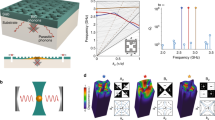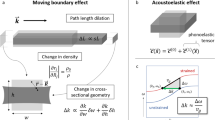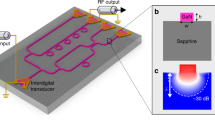Abstract
A network of bosons evolving among different modes while passing through beam splitters and phase shifters has been applied to demonstrate quantum computational advantage. While such networks have mostly been implemented in optical systems using photons, alternative realizations addressing major limitations in photonic systems such as photon loss have been explored recently. Quantized excitations of vibrational modes (phonons) of trapped ions are a promising candidate to realize such bosonic networks. Here, we demonstrate a minimal-loss programmable phononic network in which any phononic state can be deterministically prepared and detected. We realize networks with up to four collective vibrational modes, which can be extended to reveal quantum advantage. We benchmark the performance of the network for an exemplary tomography algorithm using arbitrary multi-mode states with fixed total phonon number. We obtain high reconstruction fidelities for both single- and two-phonon states. Our experiment demonstrates a clear pathway to scale up a phononic network for quantum information processing beyond the limitations of classical and photonic systems.
This is a preview of subscription content, access via your institution
Access options
Access Nature and 54 other Nature Portfolio journals
Get Nature+, our best-value online-access subscription
$29.99 / 30 days
cancel any time
Subscribe to this journal
Receive 12 print issues and online access
$209.00 per year
only $17.42 per issue
Buy this article
- Purchase on Springer Link
- Instant access to full article PDF
Prices may be subject to local taxes which are calculated during checkout




Similar content being viewed by others
Data availability
All relevant data are available from the corresponding authors upon request.
References
Aaronson, S. & Arkhipov, A. The computational complexity of linear optics. In Proc. 43rd Annual ACM Symposium on Theory of Computing. (eds. STOC 11 Conference Committee) 333–342 (ACM, 2011).
Spring, J. B. et al. Boson sampling on a photonic chip. Science 339, 798–801 (2013).
Broome, M. A. et al. Photonic boson sampling in a tunable circuit. Science 339, 794–798 (2013).
Tillmann, M. et al. Experimental boson sampling. Nat. Photon. 7, 540–544 (2013).
Crespi, A. et al. Integrated multimode interferometers with arbitrary designs for photonic boson sampling. Nat. Photon. 7, 545–549 (2013).
Carolan, J. et al. Universal linear optics. Science 349, 711–716 (2015).
Wang, H. et al. High-efficiency multiphoton boson sampling. Nat. Photon. 11, 361–365 (2017).
Wang, H. et al. Boson sampling with 20 input photons and a 60-mode interferometer in a 1014-dimensional Hilbert space. Phys. Rev. Lett. 123, 250503 (2019).
Zhong, H.-S. et al. Quantum computational advantage using photons. Science 370, 1460–1463 (2020).
Arrazola, J. M. et al. Quantum circuits with many photons on a programmable nanophotonic chip. Nature 591, 54–60 (2021).
Huh, J., Guerreschi, G. G., Peropadre, B., McClean, J. R. & Aspuru-Guzik, A. Boson sampling for molecular vibronic spectra. Nat. Photon. 9, 615–620 (2015).
Sawaya, N. P. D. & Huh, J. Quantum algorithm for calculating molecular vibronic spectra. J. Phys. Chem. Lett. 10, 3586–3591 (2019).
Shen, Y. et al. Quantum optical emulation of molecular vibronic spectroscopy using a trapped-ion device. Chem. Sci. 9, 836–840 (2018).
Banchi, L., Fingerhuth, M., Babej, T., Ing, C. & Arrazola, J. M. Molecular docking with Gaussian boson sampling. Sci. Adv. 6, eaax1950 (2020).
Arrazola, J. M. & Bromley, T. R. Using Gaussian boson sampling to find dense subgraphs. Phys. Rev. Lett. 121, 30503 (2018).
Arrazola, J. M., Bromley, T. R. & Rebentrost, P. Quantum approximate optimization with Gaussian boson sampling. Phys. Rev. A 98, 12322 (2018).
Brádler, K., Friedland, S., Izaac, J., Killoran, N. & Su, D. Graph isomorphism and Gaussian boson sampling. Spec. Matrices 9, 166–196 (2021).
Schuld, M. & Killoran, N. Quantum machine learning in feature Hilbert spaces. Phys. Rev. Lett. 122, 40504 (2019).
Chabaud, U., Markham, D. & Sohbi, A. Quantum machine learning with adaptive linear optics. Quantum 5, 496 (2021).
Brod, D. J. et al. Photonic implementation of boson sampling: a review. Adv. Photonics 1, 34001 (2019).
García-Patrón, R., Renema, J. J. & Shchesnovich, V. Simulating boson sampling in lossy architectures. Quantum 3, 169 (2019).
Qi, H., Brod, D. J., Quesada, N., & García-Patrón, R. Regimes of classical simulability for noisy Gaussian boson sampling. Phys. Rev. Lett. 124, 100502 (2020).
Quesada, N. & Arrazola, J. M. Exact simulation of Gaussian boson sampling in polynomial space and exponential time. Phys. Rev. Res. 2, 23005 (2020).
Lau, H.-K. & James, D. F. V. Proposal for a scalable universal bosonic simulator using individually trapped ions. Phys. Rev. A 85, 62329 (2012).
Shen, C., Zhang, Z. & Duan, L.-M. Scalable implementation of boson sampling with trapped ions. Phys. Rev. Lett. 112, 50504 (2014).
Chen, W., Gan, J., Zhang, J.-N., Matuskevich, D. & Kim, K. Quantum computation and simulation with vibrational modes of trapped ions. Chin. Phys. B 30, 060311 (2021).
Leibfried, D., Blatt, R., Monroe, C. & Wineland, D. Quantum dynamics of single trapped ions. Rev. Mod. Phys. 75, 281 (2003).
Brown, K. R. et al. Coupled quantized mechanical oscillators. Nature 471, 196–199 (2011).
Harlander, M., Lechner, R., Brownnutt, M., Blatt, R. & Hänsel, W. Trapped-ion antennae for the transmission of quantum information. Nature 471, 200–203 (2011).
Toyoda, K., Hiji, R., Noguchi, A. & Urabe, S. Hong–Ou–Mandel interference of two phonons in trapped ions. Nature 527, 74–77 (2015).
Debnath, S. et al. Observation of hopping and blockade of bosons in a trapped ion spin chain. Phys. Rev. Lett. 120, 73001 (2018).
Flühmann, C. et al. Encoding a qubit in a trapped-ion mechanical oscillator. Nature 566, 513–517 (2019).
Tamura, M., Mukaiyama, T. & Toyoda, K. Quantum walks of a phonon in trapped ions. Phys. Rev. Lett. 124, 200501 (2020).
Ohira, R., Mukaiyama, T. & Toyoda, K. Phonon-number-resolving detection of multiple local phonon modes in trapped ions. Phys. Rev. A 100, 60301 (2019).
James, D. F. V. Quantum dynamics of cold trapped ions, with application to quantum computation. Appl. Phys. B 66, 181–190 (1998).
Brownnutt, M., Kumph, M., Rabl, P. & Blatt, R. Ion-trap measurements of electric-field noise near surfaces. Rev. Mod. Phys. 87, 1419 (2015).
Kalincev, D. et al. Motional heating of spatially extended ion crystals. Quantum Sci. Technol. 6, 34003 (2021).
Zhang, J. et al. NOON states of nine quantized vibrations in two radial modes of a trapped ion. Phys. Rev. Lett. 121, 160502 (2018).
Maslennikov Gleband Ding, S. et al. Quantum absorption refrigerator with trapped ions. Nat. Commun. 10, 202 (2019).
Gan, H. C. J., Maslennikov, G., Tseng, K.-W., Nguyen, C. & Matsukevich, D. Hybrid quantum computing with conditional beam splitter gate in trapped ion system. Phys. Rev. Lett. 124, 170502 (2020).
Nguyen, C.-H., Tseng, K.-W., Maslennikov, G., Gan, H. C. J. & Matsukevich, D. Experimental SWAP test of infinite dimensional quantum states. Preprint at https://arxiv.org/abs/2103.10219 (2021).
Marshall, K. & James, D. F. V. Linear mode-mixing of phonons with trapped ions. Appl. Phys. B 123, 1–8 (2017).
An, S. et al. Experimental test of the quantum Jarzynski equality with a trapped-ion system. Nat. Phys. 11, 193–199 (2015).
Um, M. et al. Phonon arithmetic in a trapped ion system. Nat. Commun. 7, 11410 (2016).
Lv, D. et al. Reconstruction of the Jaynes–Cummings field state of ionic motion in a harmonic trap. Phys. Rev. A 95, 43813 (2017).
Banchi, L., Kolthammer, W. S. & Kim, M. S. Multiphoton tomography with linear optics and photon counting. Phys. Rev. Lett. 121, 250402 (2018).
Lu, Y. et al. Global entangling gates on arbitrary ion qubits. Nature 572, 363–367 (2019).
Noek, R. et al. High speed, high fidelity detection of an atomic hyperfine qubit. Opt. Lett. 38, 4735–4738 (2013).
Ding, S., Maslennikov, G., Hablützel, R. & Matsukevich, D. Cross-Kerr nonlinearity for phonon counting. Phys. Rev. Lett. 119, 193602 (2017).
Shen, C. & Duan, L. M. Correcting detection errors in quantum state engineering through data processing. N. J. Phys. 14, 53053 (2012).
Acknowledgements
This work was supported by the innovation Program for Quantum Science and Technology under grant no. 2021ZD0301602, the National Key Research and Development Program of China under grant nos. 2016YFA0301900 and 2016YFA0301901, the National Natural Science Foundation of China grant nos. 92065205 and 11974200. M.S.K.’s work was supported by the UK Hub in Quantum Computing and Simulation, part of the UK National Quantum Technologies Programme with funding from UKRI EPSRC grant EP/T001062/1 and by the Korea Institute of Science and Technology (KIST) Open Research Program. L.B. acknowledges support from the Rita Levi Montalcini program for young researchers. We thank L. You for carefully reading of the manuscript.
Author information
Authors and Affiliations
Contributions
W.C., Y.L., S.Z. and K.Z. developed the experimental system with assistance from X.S. and J.Z.. L.B. and M.S.K. provided the theoretical idea, and W.C., Y.L. and J.-N.Z. optimized experimental schemes with help from G.H. and M.Q. W.C. took and analysed the data. K.K. supervised the project. W.C., L.B., M.S.K. and K.K. contributed to the writing of the manuscript with the agreement of all the other authors.
Corresponding authors
Ethics declarations
Competing interests
The authors declare no competing interests.
Peer review
Peer review information
Nature Physics thanks the anonymous reviewers for their contribution to the peer review of this work.
Additional information
Publisher’s note Springer Nature remains neutral with regard to jurisdictional claims in published maps and institutional affiliations.
Extended data
Extended Data Fig. 1 Imaging system for the fluorescence detection of individual ion-qubit states.
The fluorescence of five ions is collected by a high NA lens and imaged to 32-channel PMT. To reduce crosstalk, we image each ion into alternative channels of PMT and put a slit at the second focused plane of the imaging system to suppress horizontal and vertical components, respectively.
Extended Data Fig. 2 Raman schematic diagram of beam-splitter.
a, Frequency arrangement of two Raman lasers from perpendicular directions. Raman I is a global laser with one frequency component, and Raman II is an individually addressed laser with two components focused on one ion. b, Energy diagram of beam-splitter. Δbs is a frequency detuning between Raman I and Raman II, effectively introducing two off-resonant RSB on a single ion. ω0 is the frequency of ion-qubit. Here two energy levels are connected by the Raman transition, \(\left| \downarrow \right\rangle _i\left| 1 \right\rangle _1\left| 0 \right\rangle _2\) and \(\left| \downarrow \right\rangle _i\left| 0 \right\rangle _1\left| 1 \right\rangle _2\).
Extended Data Fig. 3 Raman schematic diagram of beam-splitter.
a, Fidelity of a 50:50 beam-splitter with \(R_1 = {{\Delta }}_{{{{\mathrm{bs}}}}}/\sqrt {{{{\mathrm{\eta }}}}_{j,m}{{\Omega }}_{j,m}{{{\mathrm{\eta }}}}_{j,n}{{\Omega }}_{j,n}}\) and \(R_2 = {{{\mathrm{\delta }}}}\overline {{{{\mathrm{\nu }}}}_M} /{{\Delta }}_{{{{\mathrm{bs}}}}}\), where ηj,m and ηj,n are Lamb-Dicke parameters of two modes and Ωj,m is the Rabi frequency of frequency component \(f_{j,m} - f_0\). b, Prediction of operation time for a 50:50 beam-splitter. Here the simulation based on an average mode spacing of 50 kHz.
Extended Data Fig. 4 Numerical simulation for systematic errors of beam-splitters.
We simulate the performance of 50:50 beam-splitters with similar parameters used in the experiment. We achieve population errors induced by (a) heating, (b) motional decoherence, and (c) spin decoherence by subtracting inevitable errors caused by off-resonant couplings shown in Extended Data Fig. 3a. The blue points represent simulation results, with the orange fitting curves representing the error trend. The green stars represent the measurement results of the corresponding values.
Extended Data Fig. 5 Fidelity measurements of beam-splitters.
We calculate the population fidelity of beam-splitters between modes (a) 1 and 2, (b) 2 and 4, (c) 1 and 3, (d) 3 and 4, using data shown in Fig. 2. The blue circles represent the calculated fidelity, and the blue dashed lines represent the linear fitting results. The intersection of the blue and red lines represents the fidelities of the 50:50 beam splitters. All the data points occur in the figures were obtained from the mean value of 100 samples, and the error bars represent 95% confidence intervals.
Supplementary information
Supplementary Information
Supplementary Figs. 1–3 and discussion.
Rights and permissions
Springer Nature or its licensor (e.g. a society or other partner) holds exclusive rights to this article under a publishing agreement with the author(s) or other rightsholder(s); author self-archiving of the accepted manuscript version of this article is solely governed by the terms of such publishing agreement and applicable law.
About this article
Cite this article
Chen, W., Lu, Y., Zhang, S. et al. Scalable and programmable phononic network with trapped ions. Nat. Phys. 19, 877–883 (2023). https://doi.org/10.1038/s41567-023-01952-5
Received:
Accepted:
Published:
Issue Date:
DOI: https://doi.org/10.1038/s41567-023-01952-5
This article is cited by
-
Engineering colloidal semiconductor nanocrystals for quantum information processing
Nature Nanotechnology (2024)
-
Seeking a quantum advantage with trapped-ion quantum simulations of condensed-phase chemical dynamics
Nature Reviews Chemistry (2024)
-
Let the ions sing
Nature Physics (2023)



